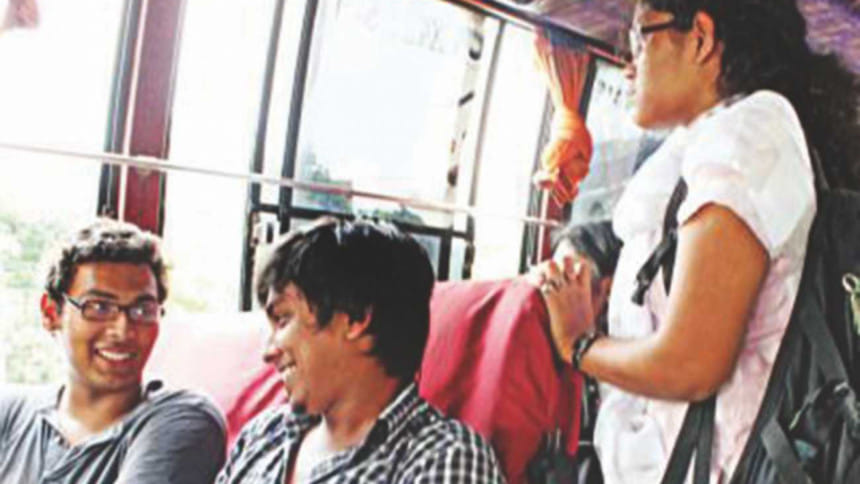Women's public transport nightmare

It is daily suffering for working women or female students who have to travel by bus across the city. It is a horrific cycle: waiting for it, getting on it, hobbling inside it or alighting from it. After a long queue, she may be lucky to be taken onboard a transport stopping for seconds! But her struggle has just begun; she would have to squeeze through the flailing human bodies, park her feet on the tiniest of space and avoid having to brush against a stranger.
Then when the time for exiting the bus comes, she would be ejected before it slowed down, risking her life and limbs in the dangerous follow through. Only the other day, I was told that a middle aged woman at the point of alighting from a bus with her child, ran to the motion of the vehicle, thankfully coming out more or less unscratched. But her child took a nasty tumble.
The Los Angeles Times in a report said that there are far fewer public transports than the number of working women in Dhaka. Result: They are subjected to humiliation and harassment, and that travelling after dusk is riskier. So it has drawn the attention of a newspaper from a faraway city where the fantasy world of Hollywood is tucked away. It is being cognizant of a mundane matter on the other side of the globe with a humanist touch.
But will it nudge the people in charge of public transportation, or for that matter, the concerned ministries into action to redress the horrific denial of a basic amenity for what is a given in any capital city worth its salt? What is the point in beating the town crier's drums over empowerment of women when a large number of them should suffer indignities during their daily commute? Or indeed, there is a shaming mismatch between catering for fundamental civic entitlements and meeting the high profile MDGs and SDGs.
A 'nothing doing' approach is taken under heaps of excuses that try as they did, they couldn't make a dent on it. Inaction cannot be an option. If the people in charge persist in this, then the conclusion would be that since they don't have to endure it, it's not their problem. It is a no brainer when you think of a basic civic infrastructural issue to be unsolvable.
Take stock of the public transports you have of mixed buses and women-only buses and the active demands for such vehicles in both categories. Work out the rate of deficit and meet it on a flexible basis. It is not rocket science to find out if re-routing a certain number of transports would ease the situation.
Statistics show that out of 450 BRTC buses, 17 are earmarked for women. The BRTC chairman points out that most of the vehicles for women run empty most of the time. In view of this, the BRTC has now decided to ply the buses only in the morning and evening hours. Even then, they don't run to full capacity probably because working women with relatives do not ride such exclusive buses. It is understandable that he cannot run at a loss. Presently, the routes that are not covered by BRTC buses may be tried out for catering for newer or potential women's demands.
What is the number of transports in the private sector? There appears to be a severe deficit in this sector. This is borne out by the fact that the reserve seats for women are routinely occupied by male passengers. The bus operators too advance a commercial argument that they cannot hold women's seats indefinitely, and thus it is expedient for them to apply first-come-first-serve basis of occupancy.
Let me offer two concrete suggestions for an improved and verifiable management of transportation service to women. In the first place, all the buses should have CCTV cameras installed in them with a button panel placed in front of the driver's seat. If he sees anything wrong, he will push the button to close the doors, encaging the trouble-maker under intimation to the nearest police posse. The attempted or real offence would be recorded and the very presence of a CCTV camera itself is sure to be a deterrent.
Secondly, we might try providing a woman martial to the vehicles who will be connected to the ground police to combat harassment and assault on travelling women.
The writer is a columnist of The Daily Star.

 For all latest news, follow The Daily Star's Google News channel.
For all latest news, follow The Daily Star's Google News channel. 



Comments